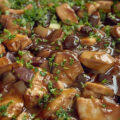If you were to walk the aisles of any Israeli grocery store, you would easily find ptitim on the shelves. Israeli kids go wild for ptitim, and it’s a feature dish on the table of many Israeli families. But where did this food come from, and why is it so popular with Israelis?
What is Ptitim?
Ptitim, which in Hebrew means “little flakes,” is what some may call Israeli couscous because of its shape. But unlike other couscous in the region, it has larger granules and is made of wheat instead of semolina. It’s a baked pasta-like product that remains firm when cooked and is usually shaped like tiny pearls. In Israel, it’s often considered a “kid’s food” because of how much Israeli children love it.
But ptitim have also gone by another name: Ben Gurion’s Rice, for Israel’s first prime minister who spearheaded the food’s creation.
History of Ptitim
Ptitim first came about in the 1950s, when the State of Israel was still in its early days, having just emerged victorious from the War of Independence. The country was in a period of austerity, and budgets were tight on every level, with even basic items, like rice, out of reach. David Ben Gurion knew that a solution needed to be found to help feed the people of Israel, so he tasked the Israeli food company, Osem, to devise a solution and figure out some kind of hearty grain based food that wouldn’t be as expensive as rice and could be easily mass produced.
Osem answered the call and invented ptitim. They chose to use wheat for their product since wheat was plentiful and didn’t cost much money to use. And thus, Ben Gurion’s rice was born. Originally, they made them in the shape of long grain rice since it was meant to be a rice substitute, but they later developed the pearl shape that we all know and enjoy today.
The people of Israel responded and loved the ptitim, catapulting it to popularity among Israeli cuisine, where it’s now considered a staple in most Israeli kitchens. Thanks to Ben Gurion and Osem, Israelis had a food they could afford and embrace.
Resemblance
Over the years, there’s been controversy and confusion surrounding ptitim because of its resemblance to other foods. Some balk at calling it “Israeli couscous” when it’s not actually in the couscous category due to the different grains being used in the respective foods, as well as the different sizes in the spheres.
Others have noticed that ptitim resembles other foods from the Mediterranean and Middle Eastern region, including marfoul, a local Arab couscous that is hand-rolled using bulgur and wheat, or risoni from Italy, where it’s more of an orzo. Some even say ptitim reminds them of farfel, an Eastern European Jewish dish with petite baked egg noodles.
Nevertheless, while ptitim may have been inspired by influences from around the region, it is an Israeli invention at its core that came about during the country’s time of need.
Ptitm Today
Ptitim continued to grow in popularity, with multiple food companies jumping on board, and by the end of the 20th century, it had been embraced by chefs across the globe. Outside of Israel, it can be found in supermarkets in countries like the U.S., where it’s labeled “pearl” or “Israeli couscous.”
While other food companies produce ptitim today, Osem remains the largest producer of ptitim and has gone on to make it in other shapes besides the famous pearl, including stars and hearts, much to the delight of Israeli children.
Ptitim is a delicious addition to any meal, and there are plenty of great recipes to choose from!
Try our Israeli Couscous (Ptitim) Mujadara

















